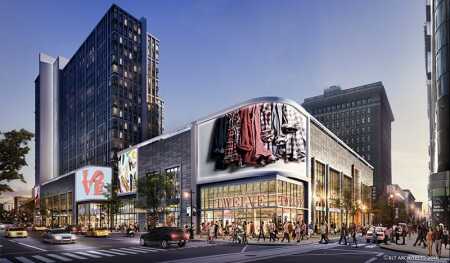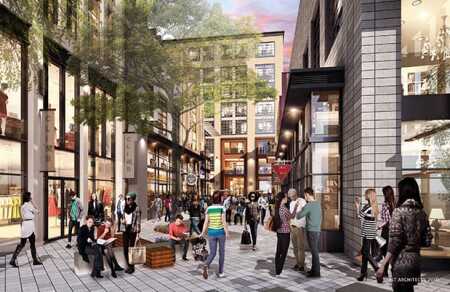As construction workers broke ground on National Real Estate Development’s half-billion-dollar, million-square-foot (93,000 sq m) East Market project in Philadelphia, they began by clearing away the last remnants of the old Snellenburg & Company department store. The once-grand, six-story brick building had seen its top floors lopped off, with the remaining two-story podium sheathed in unsightly vinyl from a 1980s redo.
As demo crews peeled off the skin of the block-long building, across from the Philadelphia Convention Center, they exposed some of the 19th-century statuary work from Market Street’s heyday as the city’s bustling department store hub. The area once boasted the world’s first Wanamaker’s location and nine similarly hulking stores like Snellenburg’s, but the interceding century was not kind to department stores or the strip.
Related: Register for the ULI Spring Meeting | Tour: The Resurgence of Retail along William Penn’s East Market Street
For decades, business on Market Street was a desolate echo of its former self, as stores shut or were demolished. Today, a new generation of developers is betting big on this long-glaring void at the heart of Philadelphia’s downtown, sandwiched between hubs of activity around Independence Mall and City Hall.
Real estate analyst Jones Lang LaSalle predicts that $1.5 billion will be spent to build out 5.5 million square feet (511,000 sq m) of leasable space over the next two years along Market Street and nearby Chestnut Street, a similarly faded retail strip a block away.
“Market Street had been the center of all commerce in Philadelphia, but you saw a long, slow decline starting in the 1970s,” says Bob Fahey Jr. of CBRE, an investment services firm that tracks local real estate. “Only in the last five years has that changed, but it’s changed dramatically.”
CBRE itself manages leasing at 833 Chestnut Street, a 1920s-era office tower that was acquired by Digital Realty Trust last year after the previous owner completed a $45 million historic renovation. The building looks out over a flurry of construction: Brickstone Companies has plans for 1,400 new apartments across five projects nearby, anchored by a $70 million, 192,000-square-foot (17,800 sq m) development that will feature downtown Philadelphia’s first Target store.
As that project topped off, Brickstone announced recently that it was acquiring a low-slung parking garage for a sixth project, to feature more apartments. Down the street, Parkway Corp., a parking lot operator, announced plans to turn a surface lot into a 300-unit high rise at a cost of $118 million.
Hines, a Texas-based apartment developer, recently broke ground on a $100 million, 322-unit tower in a partnership with the Goldenberg Group, a local developer. Goldenberg also owns a massive parking lot along Market Street, the site of a former Gimbels department store, but has not yet announced plans for that property.
Fahey says the development was being driven by a surging demand for apartments, as more downtown workers were drawn to amenities in Philadelphia’s greater Center City neighborhoods.
“You’re seeing a lot of multifamily residential. It’s people who work in Center City or the hospitals around Market Street. . . . It’s a hip place to live, a hip place to go and eat,” says Fahey.
He says he expects to see a surge in retail in coming years as thousands of new residents flood in and the area sheds its seedy reputation.
“With more people and more affluence comes more retail,” Fahey says. “But I think we’ll also see an office tower built there and probably another hotel, too, due to the proximity to Convention Center.”
Older office buildings in the area have also turned over. The Curtis Center, an aging office building, was recently purchased for $125 million by Keystone Property group, which plans a redo as luxury apartments. A former Dow Chemical office building is undergoing renovations following the departure of its anchor tenant, and Macy’s—the sole surviving department store—is looking to expand into 50,000 square feet (4,600 sq m) of new retail space.
Virtually all of this new activity emerged in the wake of NRED’s East Market plan, which will remake two existing structures while adding four new towers, and a $575 million plan to overhaul the Gallery, a 1.5 million-square-foot (139,400 sq m) urban mall that sits atop a major commuter rail station.
Initially conceived as a 1980s renewal project, the Gallery’s blank exterior walls were blamed for sucking life off of Market Street, and in later years the mall itself suffered from increasing vacancy rates. The Pennsylvania Real Estate Investment Trust (PREIT), which owns the property, partnered with national mall operator Macerich to transform the Gallery into an upscale fashion outlet while opening up more street-level stores and entrances, although it was recently announced this will not be completed at least until the end of 2018.
Jeff DeVuono, vice president at Brandywine Realty Trust, says that continued growth along the strip hinges on the outcome of these larger projects. Brandywine recently closed on a $17 million parking garage along Market Street, its first foray into the neighborhood, but has been mum about what it will do with the property.
“This was an opportunity for us to test the waters in that [east Market Street] market. If it gets successful, we can convert the site to office or residential. If it doesn’t, a lot of existing parking is getting converted, so we could charge a premium for parking,” DeVuono says. “Macerich and PREIT should really turn things around for that market. But it’s not done yet.”







